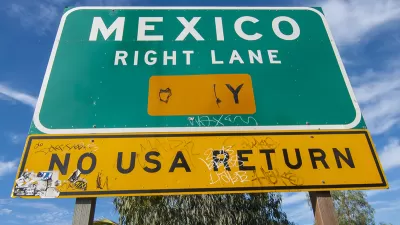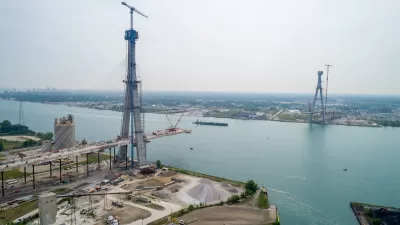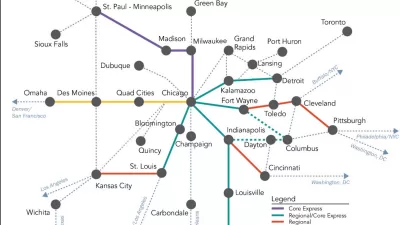Governing details a historic new infrastructure addition across the Rio Grande in Texas. The railroad crossing required a massive coordinated effort—just on the U.S. side of the border.
"Mexico and the United States haven't built a new crossing point for freight trains between the countries for more than a century. That’s about to change in the next few weeks, largely because of the efforts of local governments in South Texas," reports Daniel C. Vock.
The railroad bridge will span the Rio Grande outside of Brownsville, Texas, connecting the southernmost city in Texas to Matamoros, Mexico. The bridge, already mostly constructed, is the result of 15 years of effort by "at least three Brownsville mayors and three county 'judges,' or executives, on the American side, plus more in Mexico…"
The benefits of the new bridge are obvious and extensive: "Diverting freight trains west of the city will eliminate 14 railroad street crossings. The current route takes freight trains through residential areas, along neighborhood parks and through commercial areas…"
The article details the unique finding efforts required on the U.S. side to fund the new route as well the maze of jurisdictions that will monitor the crossing.
FULL STORY: The First New Rail Bridge to Mexico in More Than a Century

Maui's Vacation Rental Debate Turns Ugly
Verbal attacks, misinformation campaigns and fistfights plague a high-stakes debate to convert thousands of vacation rentals into long-term housing.

Planetizen Federal Action Tracker
A weekly monitor of how Trump’s orders and actions are impacting planners and planning in America.

San Francisco Suspends Traffic Calming Amidst Record Deaths
Citing “a challenging fiscal landscape,” the city will cease the program on the heels of 42 traffic deaths, including 24 pedestrians.

Defunct Pittsburgh Power Plant to Become Residential Tower
A decommissioned steam heat plant will be redeveloped into almost 100 affordable housing units.

Trump Prompts Restructuring of Transportation Research Board in “Unprecedented Overreach”
The TRB has eliminated more than half of its committees including those focused on climate, equity, and cities.

Amtrak Rolls Out New Orleans to Alabama “Mardi Gras” Train
The new service will operate morning and evening departures between Mobile and New Orleans.
Urban Design for Planners 1: Software Tools
This six-course series explores essential urban design concepts using open source software and equips planners with the tools they need to participate fully in the urban design process.
Planning for Universal Design
Learn the tools for implementing Universal Design in planning regulations.
Heyer Gruel & Associates PA
JM Goldson LLC
Custer County Colorado
City of Camden Redevelopment Agency
City of Astoria
Transportation Research & Education Center (TREC) at Portland State University
Jefferson Parish Government
Camden Redevelopment Agency
City of Claremont





























